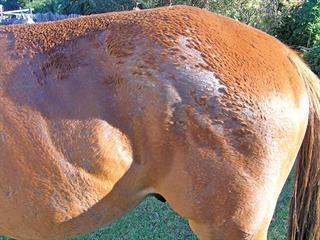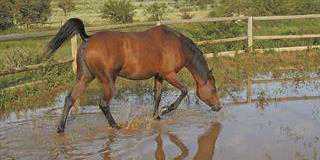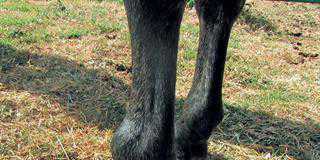
Streptothricosis (rain scald or rain rot) is a skin infection caused by Dermatophilus congolensis, an organism that thrives in warm, humid conditions. D. congolensis is not a true fungus, but an actinomycete, which behaves like both a bacterium and a fungus. A horse can be a carried without becoming infected and rain scald can also be passed from horse to horse.
Occasionally rain scald clears up on its own. Some horses shed the organism when they lose their winter coat. However, it is best not to ignore this condition. Often a secondary infection occurs, making treatment more difficult. Rain scald manifests as flaky or crusty scab-like tufts of hair on the horse’s back and rump, the back of the fetlock and front of the cannon bone. Many little scabs form and the hair is easily scraped off. The skin underneath is pink and often pussy.
The skin then becomes grey and dry – and heals.Because rain scald thrives in moist conditions, horses with thick coats are more at risk. Look for and clean any scrape or cut, as this is how the pathogen enters the dermis.
Prevention
Boots, blankets, bandages, brushes and saddles must be kept clean. Stables too need to be kept clean, as well as dry and well-ventilated. If your horse is sleeping out, use a breathable rain sheet. All horse equipment must be disinfected once a week. Use what your vet recommends, although washing everything in warm soapy water and rinsing well with vinegar helps.
Clean your stables twice a year in the following manner: remove the bedding, disinfect by broadcasting dry pool chlorine everywhere, and leave for 20 minutes. Hose and scrub the stable and walls very well. Rinse and allow to dry.
Treatment
Removing the scabs caused by D. congolensis can be very painful for your horse. I sometimes cover the scabs in a large amount of aqueous cream to soften them, but this should not be used too often. The cream increases water retention and, in turn, moisture content. Aqueous cream is fine in an emergency, if your horse is really suffering, but it’s best not to use ointments that hold moisture.
Once soft, the scabs can be removed gently. Be careful of damaging the skin further; the more damage there is, the longer the recovery process. Wash the area with a good tea tree shampoo or a lice shampoo for children. Lather well and leave for 10 minutes, then rinse. Betadine can be used and should be repeated once a day for a minimum of seven days and a maximum of 10. Protect your horse from biting insects while you are treating rain scald. Keep the animal dry and protect the affected area from sunburn. Feed it Vitamin A until the infection is under control.













